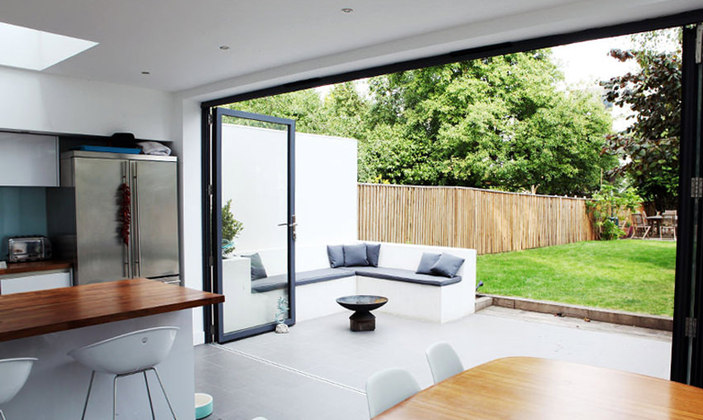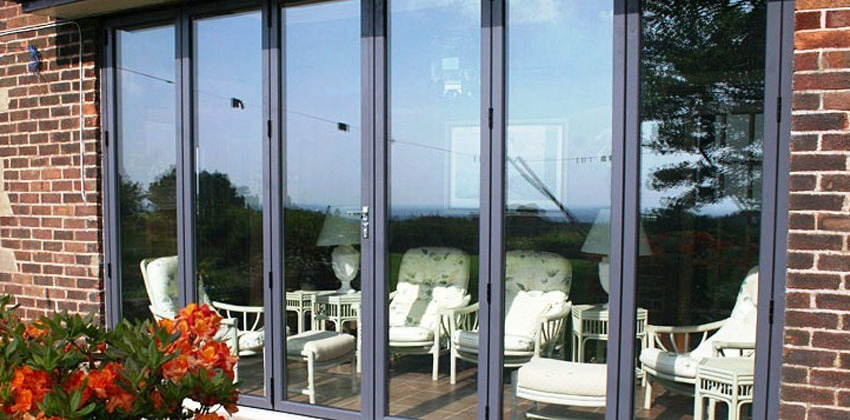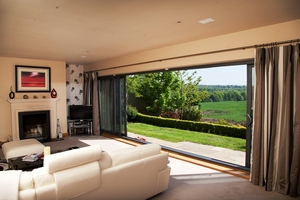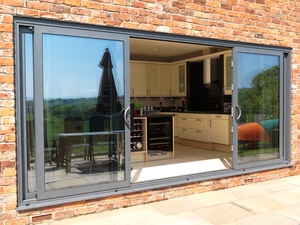Bifold vs sliding doors – the pros and cons
Bifold vs sliding doors – the pros and cons
Bifold doors that ‘bring the outside in’ have seen a huge surge in popularity in recent years but how do they differ from sliding doors? Which option is best for you?
What’s the difference?
Bifold doors fold back against themselves, concertina-style. Typically, between two and seven panels are connected by hinges and run along a concealed track on the floor or ceiling or both. Whereas sliding doors tend to be made of two or more large panes of glass which slide sideways to the end of a frame. One key difference is a sliding door doesn’t project outwards whereas a bifold door will require space for the panels to be stacked to one side.

Aluminium bifold door - photo supplied by Folding Doors To You (FD2U)
Fully openable
The major advantage of bi-fold doors is they can be folded right back, almost entirely opening up one wall to your patio and garden. This can add wow factor to your home with a flowing indoor-outdoor space. Conventional sliding doors, on the other hand, can usually only open to the left or right – about 65 per cent. Pocket doors can help. These are glass doors that slide into hidden pockets within external walls to open a larger area. The downside is reduced cavity wall insulation. Remember with the British weather, there may not be many opportunities to fully open bifold doors despite 2018 being the hottest summer on record!

Aluminium bifold door - photo supplied by Folding Doors To You (FD2U)
Flexibility
Sliding doors offer greater control. They can be opened an inch for a light breeze, a couple of feet to nip outside or all the way to let the outside in. A ‘traffic door’ or access leaf, is an option worth considering if you opt for a bifold system, especially if it’s the only door out to the garden. This is one panel that opens and shuts like a regular door, so you can go outside without folding the whole set of panels back, for example to hang the clothes out. Depending on the design, it can sit as an independent panel hinged on the wall side or form part of the folding door stack.

Sliding door - photo supplied by Folding Doors To You (FD2U)
Aesthetics – frame or glass?
The big plus for sliding doors is fewer panels and larger expanses of glass allowing natural light to flood in, brightening your home. While bi-fold doors can be pulled back to create a wider opening, when closed there’s significantly more vertical frame visible than can be achieved with sliding doors. Put simply, sliding doors have a higher glass to frame ratio. There is little to obstruct views of your garden or fields behind. Sliding doors may be a better option if your priority is maximum natural light or wider, all-year-round views of your garden.
Thresholds
With sliding patio doors there is often a frame you will need to step over to go from indoors to outdoors. Whereas bifold doors can be installed with a flush threshold opening to your patio or garden. It’s possible to specify a ‘low threshold’ with sliding patio doors, typically an aluminium strip around 12mm in height. Options are more limited because of the sliding roller mechanism within the frame but it’s achievable. There are many reasons why a flush or low threshold is a good idea such as wheelchair access and making it easier for young and old. And, of course, most people would prefer not to have an obstacle to trip over!

Sliding door - photo supplied by Folding Doors To You (FD2U)
Cost
Cost is roughly the same unless the doors get big, says Tony Wiggins, managing director of Folding Doors To You. If they get very wide, sliding doors in a few panes gets significantly more expensive because large single units of glass are very costly. The best way to compare prices for sliding and bifold doors is to ask several different companies to measure up your home extension and provide written quotes.
Energy rating
Thermally speaking, glass is the strong point of any door and the aluminium frame is the weak point. Therefore, sliding doors tend to be more thermally efficient than bifold doors as they have less frame, says installer DWL. Moreover, the company points out on its website, a sliding door profile is thicker than bifold and wins thermally in this respect too. However, architects often specify a ‘u value’ – which measures how effective a material is an insulator – and both sliding and bi-folding doors can be tailored to comply.
Choice and ease of use.
Both bifold and sliding doors can be light and easy to use, thanks to modern materials and innovative technology. They are available in a variety of materials like aluminium, wood and UPVC. Aluminium bifolds are a popular choice among homeowners as the frames are stronger than UPVC.

Wooden bifold door - photo supplied by Folding Doors To You (FD2U)
Ultimately, it is down to personal choice which is the best option. Weigh up the pros and cons and ask your building professionals for advice.
